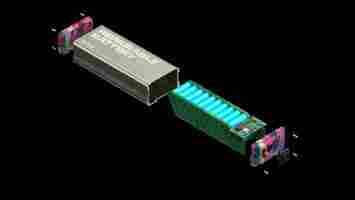Repairable batteries are critical to the EV and Ebike circular economy
Battery-powered vehicles are the future. Whether it’s EVs, ebikes, or escooters, going rechargeable is the way forward.

However, not everything is rosy with this model.
For all their green cred, most ebike batteries only last three to seven years, and cannot be easily recycled or their precious materials recovered.
Currently, the glue or welding used in designing battery packs makes it challenging to refurbish or replace cells or components within a battery.
Fortunately, this may change — because a French startup called Gouach has created a new repairable battery for micromobility vehicles.


It uses a modular, solder-less design in its batteries. This means that the electronics and cells can be changed easily. This also removes the risk of damage to the cells. This allows for an increase in battery longevity. It also reduces its carbon footprint by as much as 70%.
Their repairs take less than ten minutes at a cost of €5-€10 ($5.60 -$11.20). By comparison, it costs around €200 ($220) to replace a complete battery.
And the industry has taken note, with Gouach recently raising €3.3 million ($3.7 million) in seed funding.
The modular design means all batteries parts can be dismantled and fixed.
Dott uses repairable batteries to help close its battery loop
Micromobility provider Dott is using the repairable batteries on its ebikes and escooters. Their modular design makes it easy to disassemble and repair batteries with minor defects and get the batteries back into its vehicles.
As the company asserts:
It’s terrific to see companies making further steps towards sustainability. However, there needs to be more pressure for repairable batteries becoming a reality on the regulatory side.
Research conducted by the International Institute for Industrial Environmental Economics (IIIEE) the European Environmental Bureau (EEB), and the Right to Repair campaign late last year found that software locks hinder battery refurbishment.
They discovered that ebikes designed and manufactured by Bosch , Yamaha, and Specialized are examples of brands that use software locks.
Furthermore, while battery cells have a standard format ( 18650 being the most popular), the battery packs and management systems are tailored to manufacturers and sometimes to specific bike models, creating barriers to repair and replacement .
EU legislation would help solve this issue across the region. If ebike makers and manufacturers had to abide by regulations regarding the right to repair, refurbishment, and responsible recycling, this would advance true electric battery sustainability .
A rechargeable future is possible and inevitable — but there’s still a lot to do to ensure that the impact can represent the growth of ebikes and escooters.
After four years of waiting, Indians might finally get their taste of Tesla this year
After years of Elon Musk hinting at the idea, it seems Tesla is finally going to make inroads into India.

According to an Economic Times report published at the end of December, India’s transport minister Nitin Gadkari has confirmed the American EV maker will arrive in the country this year.
“American auto major Tesla will have its distribution facility (sale centers) for its cars in India from next year and, considering the demand, it would look into setting up of manufacturing here (too),” Gadkari told the Economic Times.
The first step will see Tesla set up sales operations in the country, and could eventually consider local assembly and manufacturing. Geographically speaking, it makes most sense for the Indian market to be served by Tesla’s China-based factory.
SHIFT is brought to you by Polestar. It’s time to accelerate the shift to sustainable mobility. That is why Polestar combines electric driving with cutting-edge design and thrilling performance. Find out how .
Polestar challenges itself to make an entirely carbon neutral car by 2030
Last year, on World EV day, Polestar CEO Thomas Ingenlath declared that “ Electric cars are not clean .” With its latest announcement, it seems the startup EV maker is keen to address that fact.

Today, as part of its first annual review, Polestar has declared its ambition to make a car that’s entirely climate neutral by 2030, in what it dubs the Polestar 0 project.
While Polestar already makes a battery electric car — the Polestar 2 — that has zero tailpipe emissions, as with other EVs CO2 is created during its production.
It comes as no surprise, that eliminating production emissions will be the main area of focus for Polestar as it seeks to build a climate neutral EV.
What’s Polestar’s plan?
Rather than planting trees to offset the carbon produced during vehicle manufacture, Polestar is aiming to eliminate emissions altogether, with a philosophy it calls “design towards zero.”
“Offsetting is a cop-out,” Polestar CEO Thomas Ingenlath, said in a statement. “ By pushing ourselves to create a completely climate-neutral car, we are forced to reach beyond what is possible today. We will have to question everything, innovate and look to exponential technologies as we design towards zero. ”
That’s a simple idea, but making it a reality will be a much greater challenge.
A car has some 30,000 components, and building one relies on complex relationships between suppliers and sub-manufacturers, that all have to come together in perfect timing for production to happen smoothly.
“We don’t have to worry about combustion engines producing toxic emissions — but that doesn’t mean our job is done,” said Polestar ‘s Head of Sustainability, Fredrika Klarén.
“We will now work to eradicate all emissions stemming from production,” she added.
The Volvo and Geely founded EV maker says it is going to focus on five key areas in its pursuit to build a climate neutral car. These being:
Building a climate neutral platform that models can be built on
Using climate neutral materials
Energy optimization
Climate neutral manufacturing
Installing renewable energy in its supply chain
Polestar is aware of the challenge that lies ahead, and while it does have a strategic roadmap for its 2030 goal, it realizes there are many questions and answers left to be discovered.
Alongside Polestar’s ambitions to make a climate neutral vehicle, it will more clearly disclose the carbon footprint and traced risk materials of its vehicles on its website and at its Spaces retail outlets.
One of the big arguments detractors make against EVs is the carbon footprint associated with their production. Typically, it’s far bigger than that of a comparable gasoline vehicle, however, as soon as the vehicles hit the road, the EV catches up and overtakes the gasoline car in terms of lifetime emissions.
Hopefully, there will come a day when we can purchase an EV that doesn’t come with any production emissions. When that day does come, it will surely spell the absolute end of the argument over what’s the better choice for the environment: gasoline vehicles or EVs.
Do EVs excite your electrons? Do ebikes get your wheels spinning? Do self-driving cars get you all charged up?
Then you need the weekly SHIFT newsletter in your life. Click here to sign up .